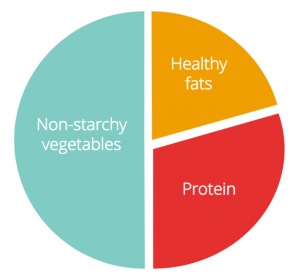Low Carb – the info…
Low Carbohydrate Meal Planning
Many meals can be included in a low-carb meal plan, simply by following the pattern of:
-Choose a protein (e.g. chicken, turkey, salmon or beef).-Add ½ a plate of non-starchy vegetables (e.g. peppers, spinach or brussels sprouts).
-Include a small portion of healthy fats (e.g. avocado, seeds/nuts or olive oil).
Note. Protein substitutes can be made for vegetarians, such as soy products, eggs or pulses. Beans, legumes, and pulses provide carbohydrate as well as protein, so be mindful of this – you may need to reduce the amount of other carbohydrates you choose in a meal with these.
Here are some low-carb tips for you:

Easy swaps to make your favourite meals low-carb
Eating low-carb doesn’t have to mean sacrificing the meals you love. As with anything in life, slow and steady wins the race. If you start by making small changes you are more likely to stick with these changes in the long-term.
Making simple swaps for the carbohydrate element of your meal to low-carb foods is a good way to keep enjoying the food you love, while still reducing the carb content.
CARB SWAPRice Cauliflower Rice
Spaghetti Courgetti (spiralised courgette)
Mashed potato Cauliflower mash
Chips Celeriac chips
Tortilla wraps Lettuce wraps
Couscous Quinoa
Roast potatoes Roast carrots
Crisps Kale crisps
Difference between low-carb and keto
Although many of the recipes above can be used as keto recipes, a low-carbohydrate diet is not to be confused for a ketogenic (keto) diet. The more extreme keto diet almost eliminates carbs rather than aiming to reduce them.
This process deprives the body of its primary source of fuel, glucose. As a result, the body has no choice but to create new metabolic pathways and start burning fat (or more accurately, ketones produced from the breakdown of fats) for energy instead. This is called ketosis.
This may sound ideal, but while eating keto does burn fat, it is very difficult to follow effectively in the long term, as one slip up will take you out of ketosis.
There is no official definition of a ‘low’ or ‘lower’ carb diet. Research often uses many different classifications, but as a general overview, a lower carb diet is around 30% of your overall daily energy intake from carbs. This is roughly <100g of carbs (total) per day. Practical tips on how to eat low-carbWhen you do eat carbs, you should opt for complex carbohydrates (for example, sweet potato, oats, or wholewheat pasta). These have a larger molecular structure than simple carbohydrates (for example, white rice, white bread, or white pasta) and contain more fibre. Fibre makes us feel fuller for longer, and has many other .
If you are following a low-carb, balanced diet aim to have 1-3 servings of complex carbohydrates per day.
The following examples are one serving of complex carbohydrates and contain roughly 15g of carbohydrate:
80g cooked or 1⁄2 uncooked medium potato or sweet potato.1 thin slice of wholemeal or wholegrain bread.
1⁄2 wholemeal pitta bread or bread roll.
1⁄2 wholemeal wrap.
20g uncooked or 50g (roughly 1⁄2 cup) cooked brown rice or wholewheat pasta.
20g raw wholegrain cereal, oats, or shredded wheat (approx. 1/3 cup); or 1 wheat biscuit.
Take home message
-Eating low-carb can be easy and doesn’t mean sacrificing the foods you love.-Low-carb is different from a keto diet, which almost eliminates carbs completely.
-To eat low-carb you should aim for maximum 1-3 15g servings of carbs per day.
-Low-carb diets are very effective for weight loss.
